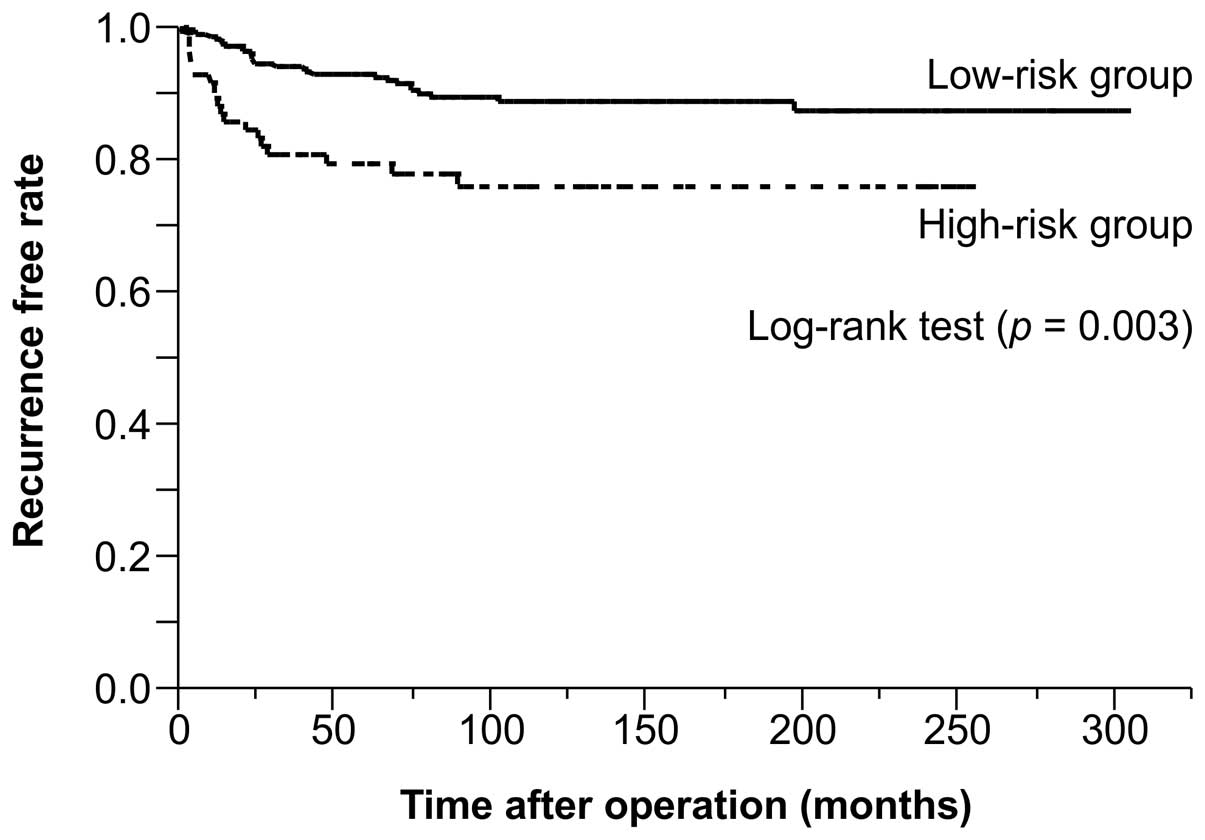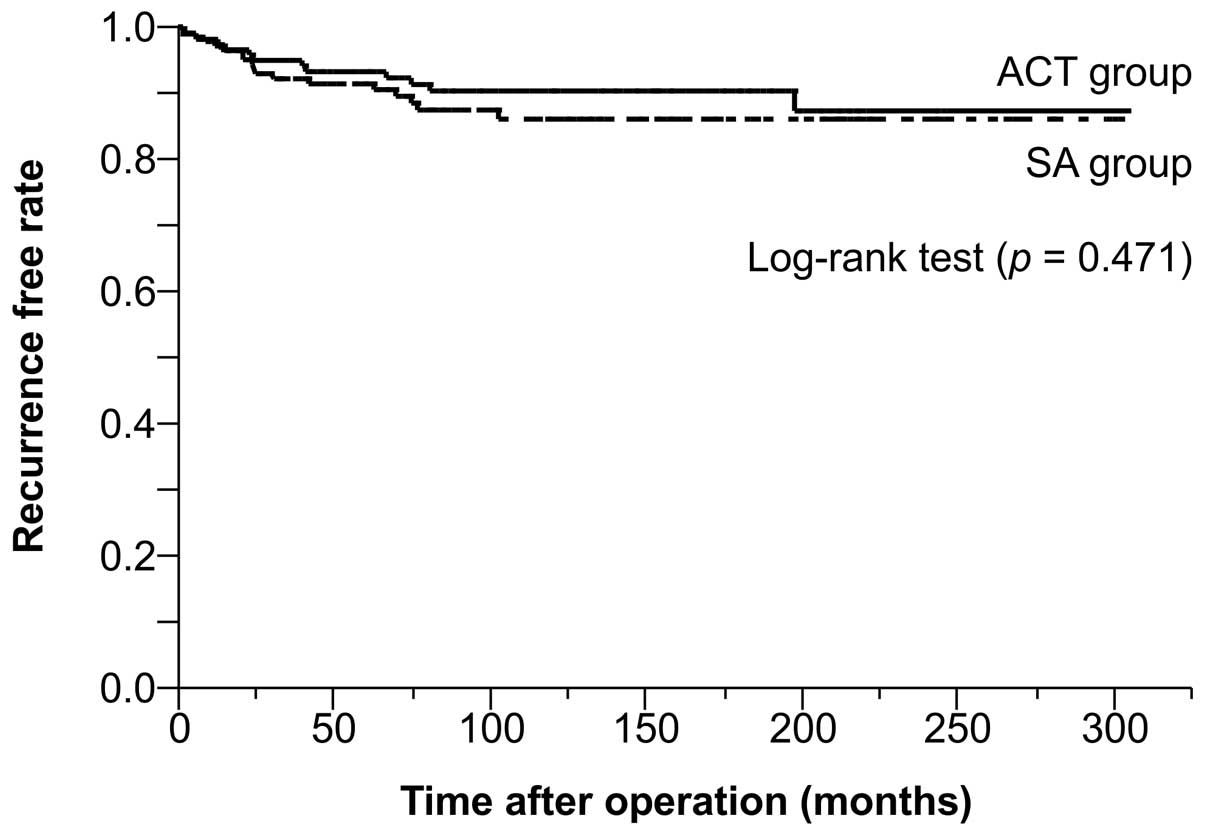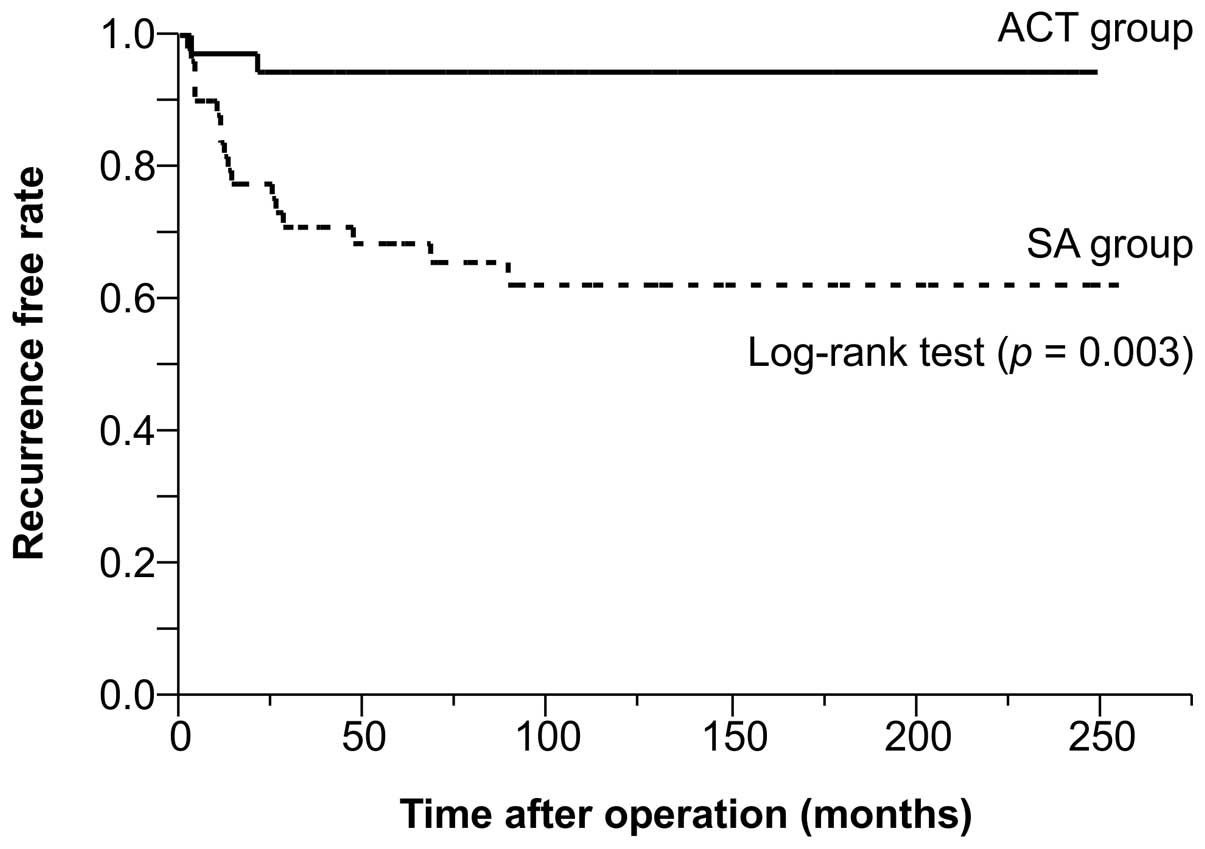|
1
|
No authors listed. Efficacy of adjuvant
fluorouracil and folinic acid in B2 colon cancer: International
Multicentre Pooled Analysis of B2 Colon Cancer Trials (IMPACT B2)
Investigators. J Clin Oncol. 17:1356–1363. 1999.PubMed/NCBI
|
|
2
|
Moertel CG, Fleming TR, Macdonald JS, et
al: Intergroup study of fluorouracil plus levamisole as adjuvant
therapy for stage II/Dukes’ B2 colon cancer. J Clin Oncol.
13:2936–2943. 1995.PubMed/NCBI
|
|
3
|
Benson AB 3rd, Schrag D, Somerfield MR, et
al: American Society of Clinical Oncology recommendations on
adjuvant chemotherapy for stage II colon cancer. J Clin Oncol.
22:3408–3419. 2004. View Article : Google Scholar : PubMed/NCBI
|
|
4
|
Labianca R, Nordlinger B, Beretta GD,
Brouquet A and Cervantes A; ESMO Guidelines Working Group. Primary
colon cancer: ESMO Clinical Practice Guidelines for diagnosis,
adjuvant treatment and follow-up. Ann Oncol. 21(Suppl 5): v70–v77.
2010. View Article : Google Scholar : PubMed/NCBI
|
|
5
|
Watanabe T, Itabashi M, Shimada Y, et al;
Japanese Society for Cancer of the Colon and Rectum. Japanese
Society for Cancer of the Colon and Rectum (JSCCR) guidelines 2010
for the treatment of colorectal cancer. Int J Oncol. 1–29. 2012.
View Article : Google Scholar : PubMed/NCBI
|
|
6
|
Sato H, Maeda K, Sugihara K, et al:
High-risk stage II colon cancer after curative resection. J Surg
Oncol. 104:45–52. 2011. View Article : Google Scholar : PubMed/NCBI
|
|
7
|
Ogata Y, Murakami H, Sasatomi T, et al:
Elevated preoperative serum carcinoembrionic antigen level may be
an effective indicator for needing adjuvant chemotherapy after
potentially curative resection of stage II colon cancer. J Surg
Oncol. 99:65–70. 2009. View Article : Google Scholar
|
|
8
|
Punt CJ, Buyse M, Köhne CH, et al:
Endpoints in adjuvant treatment trials: a systematic review of the
literature in colon cancer and proposed definitions for future
trials. J Natl Cancer Inst. 99:998–1003. 2007. View Article : Google Scholar : PubMed/NCBI
|
|
9
|
Sobin LH, Gospodarowicz MK and Wittekind
C: TNM classification of malignant tumours. 7th edition.
Wiley-Blackwell; New York, NY: 2009
|
|
10
|
Shirouzu K, Isomoto H, Morodomi T and
Kakegawa T: Carcinomatous lymphatic permeation. Prognostic
significance in patients with rectal carcinoma - a long term
prospective study. Cancer. 75:4–10. 1995. View Article : Google Scholar : PubMed/NCBI
|
|
11
|
Shirouzu K, Isomoto H, Kakegawa T and
Morimatsu M: A prospective clinicopathologic study of venous
invasion in colorectal cancer. Am J Surg. 162:216–222. 1991.
View Article : Google Scholar : PubMed/NCBI
|
|
12
|
Schrag D, Rifas-Shiman S, Saltz L, Bach PB
and Begg CB: Adjuvant chemotherapy use for Medicare beneficiaries
with stage II colon cancer. J Clin Oncol. 20:3999–4005. 2002.
View Article : Google Scholar : PubMed/NCBI
|
|
13
|
Gertler R, Rosenberg R, Schuster T and
Friess H: Defining a high-risk subgroup with colon cancer stages I
and II for possible adjuvant therapy. Eur J Cancer. 45:2992–2999.
2009. View Article : Google Scholar : PubMed/NCBI
|
|
14
|
Kobayashi H, Mochizuki H, Sugihara K, et
al: Characteristics of recurrence and surveillance tools after
curative resection for colorectal cancer: a multicenter study.
Surgery. 141:67–75. 2007. View Article : Google Scholar : PubMed/NCBI
|
|
15
|
Manfredi S, Bouvier AM, Lepage C, Hatem C,
Dancourt V and Faivre J: Incidence and patterns of recurrence after
resection for cure of colonic cancer in a well defined population.
Br J Surg. 93:1115–1122. 2006. View
Article : Google Scholar : PubMed/NCBI
|
|
16
|
van Leeuwen BL, Påhlman L, Gunnarsson U,
Sjövall A and Martling A: The effect of age and gender on outcome
after treatment for colon carcinoma. A population-based study in
the Uppsala and Stockholm region. Crit Rev Oncol Hematol.
67:229–236. 2008.PubMed/NCBI
|
|
17
|
McArdle CS, McMillan DC and Hole DJ: Male
gender adversely affects survival following surgery for colorectal
cancer. Br J Surg. 90:711–715. 2003. View
Article : Google Scholar : PubMed/NCBI
|
|
18
|
Wichmann MW, Müller C, Hornung HM,
Lau-Werner U and Schildberg FW; Colorectal Cancer Study Group.
Gender differences in long-term survival of patients with
colorectal cancer. Br J Surg. 88:1092–1098. 2001. View Article : Google Scholar : PubMed/NCBI
|
|
19
|
Oñate-Ocaña LF, Montesdeoca R,
López-Graniel CM, et al: Identification of patients with high-risk
lymph node-negative colorectal cancer and potential benefit from
adjuvant chemotherapy. Jpn J Clin Oncol. 34:323–328.
2004.PubMed/NCBI
|
|
20
|
Chou CL, Chang SC, Lin TC, et al:
Differences in clinicopathological characteristics of colorectal
cancer between younger and elderly patients: an analysis of 322
patients from a single institution. Am J Surg. 202:574–582. 2011.
View Article : Google Scholar : PubMed/NCBI
|
|
21
|
Quah HM, Chou JF, Gonen M, et al:
Identification of patients with high-risk stage II colon cancer for
adjuvant therapy. Dis Colon Rectum. 51:503–507. 2008. View Article : Google Scholar : PubMed/NCBI
|
|
22
|
Burdy G, Panis Y, Alves A, Nemeth J,
Lavergne-Slove A and Valleur P: Identifying patients with T3–T4
node-negative colon cancer at high risk of recurrence. Dis Colon
Rectum. 44:1682–1688. 2001.
|
|
23
|
Lin CC, Lin JK, Chang SC, et al: Is
adjuvant chemotherapy beneficial to high risk stage II colon
cancer? Analysis in a single institute. Int J Colorectal Dis.
24:665–676. 2009. View Article : Google Scholar : PubMed/NCBI
|
|
24
|
Mulcahy HE, Toner M, Patchett SE, Daly L
and O’Donoghue DP: Identifying stage B colorectal cancer patients
at high risk of tumor recurrence and death. Dis Colon Rectum.
40:326–331. 1997. View Article : Google Scholar : PubMed/NCBI
|
|
25
|
Chin CC, Wang JY, Changchien CR, Huang WS
and Tang R: Carcinoma obstruction of the proximal colon cancer and
long-term prognosis - obstruction is a predictor of worse outcome
in TNM stage II tumor. Int J Colorectal Dis. 25:817–822. 2010.
View Article : Google Scholar : PubMed/NCBI
|
|
26
|
Katoh H, Yamashita K, Wang G, Sato T,
Nakamura T and Watanabe M: Prognostic significance of preoperative
bowel obstruction in stage III colorectal cancer. Ann Surg Oncol.
18:2432–2441. 2011. View Article : Google Scholar : PubMed/NCBI
|
|
27
|
Gold P and Freedman SO: Demonstration of
tumor-specific antigens in human colonic carcinomata by
immunological tolerance and absorption techniques. J Exp Med.
121:439–462. 1965. View Article : Google Scholar : PubMed/NCBI
|
|
28
|
Harrison LE, Guillem JG, Paty P and Cohen
AM: Preoperative carcinoembryonic antigen predicts outcomes in
node-negative colon cancer patients: a multivariate analysis of 572
patients. J Am Coll Surg. 185:55–59. 1997. View Article : Google Scholar
|
|
29
|
Wolmark N, Fisher B, Wieand HS, et al: The
prognostic significance of preoperative carcinoembryonic antigen
levels in colorectal cancer. Results from NSABP (National Surgical
Adjuvant Breast and Bowel Project) clinical trials. Ann Surg.
199:375–382. 1984. View Article : Google Scholar
|
|
30
|
Sener SF, Imperato JP, Chmiel J, Fremgen A
and Sylvester J: The use of cancer registry data to study
preoperative carcinoembryonic antigen level as an indicator of
survival in colorectal cancer. CA Cancer J Clin. 39:50–57. 1989.
View Article : Google Scholar : PubMed/NCBI
|
|
31
|
Wagner HE, Toth CA, Steele GD Jr and
Thomas P: Metastatic potential of human colon cancer cell lines:
relationship to cellular differentiation and carcinoembryonic
antigen production. Clin Exp Metastasis. 10:25–31. 1992. View Article : Google Scholar : PubMed/NCBI
|
|
32
|
Locker GY, Hamilton S, Harris J, et al;
ASCO. ASCO 2006 update of recommendations for the use of tumor
markers in gastrointestinal cancer. J Clin Oncol. 24:5313–5327.
2006. View Article : Google Scholar : PubMed/NCBI
|
|
33
|
Van Cutsem EJ and Oliveira J; ESMO
Guidelines Working Group. Colon cancer: ESMO clinical
recommendations for diagnosis, adjuvant treatment and follow-up.
Ann Oncol. 19(Suppl 2): ii29–ii30. 2008.
|

















